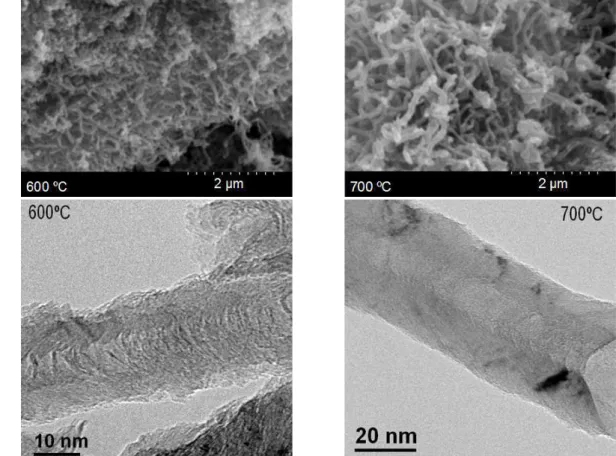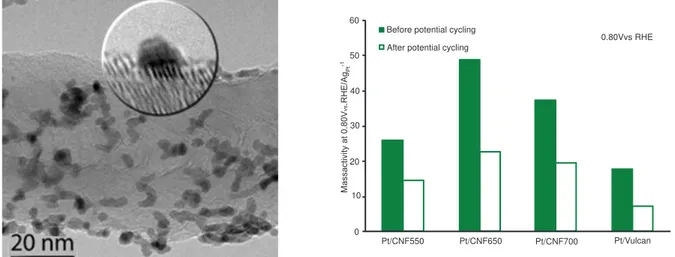nº23/Marzo 2012
1. Objectives and novelty
Novel carbon nanostructures have attracted a great interest as they combine unique properties that are difficult to be found in other conventional materials and, consequently, present the potential to fulfill the requirements of certain applications in fields of social and/or technological concerns like energy, catalysis, and electronics. Among them, carbon nanofibers (CNFs) are filaments of nanometer size (diameter up to 100 nm) formed by stacking graphene layers at a certain orientation. Their external porous structure together with their graphitic character that results in a high conductivity, make CNFs a promising candidate for their application in electrocatalytic systems. Carbon nanofibers are grown in a whisker-like mode by the precipitation of carbon on specific metal surfaces, so the shape of the metal particles and the diffusivity of carbon through them, determine the rate of growth, the orientation of the graphene layers and the size of the filament.
The present work aimed to gain an insight into the physical-chemical properties of carbon nanofibers and the relationship between those properties and the electrocatalytic behavior when used as catalyst support for their application in fuel cells. Several strategies are studied to modify CNFs properties: variation of synthesis operating conditions (temperature, gas composition and gas space velocity), functionalization with strong acids and chemical activation. A particularly interesting analysis of the electronic conductivity of CNFs is carried out for the first time, as this property can result of interest for several purposes (electronics, composites, etc.).
Afterwards, electrocatalysts are synthesized using CNFs as support to deposit nanoparticulated platinum and platinum-ruthenium alloys. These electrocatalysts are tested for the oxidation of methanol and ethanol as well as for the reduction of oxygen, which are the rate determining reactions in polymeric fuel cells. The study enables to select the most appropriate support material in terms of performance and durability, resulting in enhanced behavior with respect to the state of the art commercial supports.
2. Results
Carbon nanofibers, obtained by the catalytic decomposition of methane on a nickel-based catalyst, were observed to present different properties as a function of synthesis conditions (temperature, gas composition and space velocity), where temperature is remarkably the variable of highest influence. In general terms, textural properties like surface area and pore volume are favored by CNF synthesis at low temperature (550ºC) and high gas space velocity. On the contrary, the carbon ordering degree (crystallinity and low density of defects) and the related properties (e.g. electronic conductivity) are favored by the synthesis at relatively high temperatures (700-750 ºC) and introducing a certain concentration of hydrogen (10-15 %vol.). As an example, the SEM and HRTEM images of Figure 1 illustrate the morphological differences of CNFs obtained at two different synthesis temperatures. CNF surface chemistry can be modified introducing oxygen groups by chemical oxidation with strong acids. Although carbonyl is the most abundant group,
S. del Río
Presented in 2011, ICB-CSIC
S u p e rv is o rs : Rafael Moliner Álvarez and Mª Jesús Lázaro Elorri.ICB-CISIC. Miguel Luesma Castán 4,
50015 Zaragoza, Spain
Bol. Grupo Español Carbón
Figure 2. HRTEM image of Pt nanoparticles dispersed on CNFs (left); and oxygen reduction activity enhancement with the use of CNFs with respect to Vulcan commercial support (right).
the relative amount of carboxylic acids and phenols can be increased by elevating oxidation temperature. Some properties are significantly changed with functionalization, such as the electronic conductivity, which decreases significantly with the introduction of oxygen. On the other hand, the activation of carbon nanofibers with potassium hydroxide is detrimental for their fibrous structure, increasing the surface area up to 60% by the fragmentation of the filaments. Platinum and platinum-ruthenium nanoparticles were supported on CNFs by a microemulsion procedure (Figure 2). The main advantage of this method, compared to conventional impregnation, is the control of the metal crystal size (3 nm for Pt and 2 nm for PtRu alloys), with a narrow size distribution and independently of the support features, even for low surface area CNFs.
The electrocatalytic activity was found to depend on the carbon nanofibers characteristics. An optimum catalytic activity is obtained in a compromise situation between the properties derived from texture and those derived from crystallinity. High carbon crystalline order favors the catalyst specific activity (A/m2metal), whereas a high support surface area favors the dispersion of the nanoparticles, increasing the electrochemically active surface area (m2/gmetal). The optimum mass activity (A/gmetal) is thus the product of these parameters and it is different for each electrochemical process. Methanol oxidation, this is, the anodic reaction of direct methanol fuel cells (DMFC), is favored using highly ordered carbon nanofibers. On the contrary, ethanol oxidation (anode of direct ethanol fuel cells) and oxygen reduction (cathodic reaction) are favored when supporting metal nanoparticles on CNF with improved textural properties. Higher performances were found for the Pt catalysts supported on CNF than supported on the state-of-the-art commercial carbon black (Vulcan), as can be seen in Figure 2.
Accelerated degradation tests were also carried out. The platinum sintering causes a decrease of the electrochemical surface area which causes a decrease in activity. In the case of carbon corrosion, it has been observed that carbon crystallinity favors the corrosion resistance. The best choice in terms of durability is again the result of a compromise situation between an appropriate dispersion of Pt nanoparticles (high surface area of CNFs), which prevents them from agglomeration, and a high crystallinity of the support, which reduces the corrosion rate.
3. Conclusions
The physical-chemical properties of CNFs as well as their surface chemistry can be tuned by an adequate choice of synthesis conditions, favoring a certain group of properties (porosity) or the other (crystallinity). Platinum-based catalysts have been supported on CNFs with different characteristics and their catalytic activity has been proven to depend on the support features, obtaining an optimum support for each electrochemical process in terms of performance and durability.
4. Related publications
1
Lázaro MJ, Sebastián D, Suelves I, Moliner R, Carbon nanofiber growth optimization for their use as electrocatalyst support in proton exchange membrane (PEM) fuel cells. J Nanosci Nanotechnol, 2009; 9, 4353-4359.
2
Sebastián D, Suelves I, Lázaro MJ, Moliner R, Carbon nanofibers as electrocatalyst support for fuel cells: the effect of hydrogen on their properties in CH4 decomposition. J Power Sources, 2009; 192, 51-56.
3
Sebastián D, Calderón JC, González-Expósito JA, Pastor E, Martínez-Huerta MV, Suelves I, Moliner R, Lázaro MJ, Influence of carbon nanofiber properties as electrocatalyst support on the electrochemical performance for PEM fuel cells. Int J Hydrogen Energy, 2010; 35, 9934-9942. 4
Sebastián D, Suelves I, Moliner R, Lázaro MJ, The effect of the functionalization of carbon nanofibers on their electronic conductivity. Carbon, 2010; 48, 4421-4431.
5
Sebastián D, Lázaro MJ, Suelves I, Moliner R, Baglio V, Stassi A, Aricò AS, The influence of carbon nanofiber support properties on the oxygen reduction behavior in proton conducting electrolyte-based direct methanol fuel cells. Int J Hydrogen Energy, 2011; in press, doi:10.1016/j.ijhydene.2011.07.004. 6
Sebastián D, Ruiz AG, Suelves I, Moliner R, Lázaro MJ, Baglio V, Stassi A, Aricò AS, Enhanced oxygen reduction activity and durability of Pt catalysts supported on carbon nanofibers. Appl Catal, B, 2012; 115-116, 269-275.
Full Thesis can be downloaded from the URL: h t t p : / / d i g i t a l . c s i c . e s / h a n d l e / 1 0 2 6 1 / 3 7 7 0 7
Pt/CNF550 Pt/CNF650 Pt/CNF700 Pt/Vulcan Before potential cycling
After potential cycling
0 30
20
10 60
50
40

